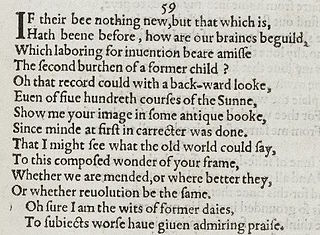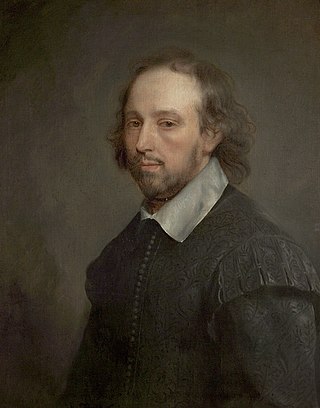
"Ozymandias" is a sonnet written by the English Romantic poet Percy Bysshe Shelley (1792–1822). It was first published in the 11 January 1818 issue of The Examiner of London. The poem was included the following year in Shelley's collection Rosalind and Helen, A Modern Eclogue; with Other Poems, and in a posthumous compilation of his poems published in 1826.
Hyperion, a Fragment is an abandoned epic poem by 19th-century English Romantic poet John Keats. It was published in Lamia, Isabella, The Eve of St. Agnes, and Other Poems (1820). It is based on the Titanomachia, and tells of the despair of the Titans after their fall to the Olympians. Keats wrote the poem from late 1818 until the spring of 1819, when he gave it up as having "too many Miltonic inversions". He was also nursing his younger brother Tom, who died on 1 December 1818 of tuberculosis.

William Shakespeare (1564–1616) wrote sonnets on a variety of themes. When discussing or referring to Shakespeare's sonnets, it is almost always a reference to the 154 sonnets that were first published all together in a quarto in 1609. However, there are six additional sonnets that Shakespeare wrote and included in the plays Romeo and Juliet, Henry V and Love's Labour's Lost. There is also a partial sonnet found in the play Edward III.

"Ode to a Nightingale" is a poem by John Keats written either in the garden of the Spaniards Inn, Hampstead, London or, according to Keats' friend Charles Armitage Brown, under a plum tree in the garden of Keats' house at Wentworth Place, also in Hampstead. According to Brown, a nightingale had built its nest near the house that he shared with Keats in the spring of 1819. Inspired by the bird's song, Keats composed the poem in one day. It soon became one of his 1819 odes and was first published in Annals of the Fine Arts the following July. The poem is one of the most frequently anthologized in the English language.

The "Ode on Indolence" is one of five odes composed by English poet John Keats in the spring of 1819. The others were "Ode on a Grecian Urn", "Ode on Melancholy", "Ode to a Nightingale" and "Ode to Psyche". The poem describes the state of indolence, a word which is synonymous with "avoidance" or "laziness". The work was written during a time when Keats was presumably more than usually occupied with his material prospects. After finishing the spring poems, Keats wrote in June 1819 that its composition brought him more pleasure than anything else he had written that year. Unlike the other odes he wrote that year, "Ode on Indolence" was not published until 1848, 27 years after his death.

"On First Looking into Chapman's Homer" is a sonnet written by the English Romantic poet John Keats (1795–1821) in October 1816. It tells of the author's astonishment while he was reading the works of the ancient Greek poet Homer, who was freely translated by the Elizabethan playwright George Chapman.
"Lamia" is a narrative poem written by the English poet John Keats, which first appeared in the volume Lamia, Isabella, the Eve of St Agnes and Other Poems, published in July 1820. The poem was written in 1819, during the famously productive period that produced his 1819 odes. It was composed soon after his "La Belle Dame sans Merci" and his odes on Melancholy, on Indolence, on a Grecian Urn and to a Nightingale and just before "To Autumn".
"When I Have Fears" is an Elizabethan sonnet by the English Romantic poet John Keats. The 14-line poem is written in iambic pentameter and consists of three quatrains and a couplet. Keats wrote the poem between 22 and 31 January 1818. It was published (posthumously) in 1848 in Life, Letters, and Literary Remains, of John Keats by Richard Monckton Milnes.

"Bright star, would I were stedfast as thou art" is a love sonnet by John Keats.

Endymion is a poem by John Keats first published in 1818 by Taylor and Hessey of Fleet Street in London. John Keats dedicated this poem to the late poet Thomas Chatterton. The poem begins with the line "A thing of beauty is a joy for ever". Endymion is written in rhyming couplets in iambic pentameter. Keats based the poem on the Greek myth of Endymion, the shepherd beloved of the moon goddess Selene. The poem elaborates on the original story and renames Selene "Cynthia".

"Ode to Psyche" is a poem by John Keats written in spring 1819. The poem is the first of his 1819 odes, which include "Ode on a Grecian Urn" and "Ode to a Nightingale". "Ode to Psyche" is an experiment in the ode genre, and Keats's attempt at an expanded version of the sonnet format that describes a dramatic scene. The poem serves as an important departure from Keats's early poems, which frequently describe an escape into the pleasant realms of one's imagination. Keats uses the imagination to show the narrator's intent to resurrect Psyche and reincarnate himself into Eros (love). Keats attempts this by dedicating an "untrodden region" of his mind to the worship of the neglected goddess.

Elizabethan literature refers to bodies of work produced during the reign of Queen Elizabeth I (1558–1603), and is one of the most splendid ages of English literature. In addition to drama and the theatre, it saw a flowering of poetry, with new forms like the sonnet, the Spenserian stanza, and dramatic blank verse, as well as prose, including historical chronicles, pamphlets, and the first English novels. Major writers include William Shakespeare, Edmund Spenser, Christopher Marlowe, Richard Hooker, Ben Jonson, Philip Sidney and Thomas Kyd.
"Sleep and Poetry" (1816) is a poem by the English Romantic poet John Keats. It was started late one evening while staying the night at Leigh Hunt's cottage. It is often cited as a clear example of Keats's bower-centric poetry, yet it contains lines that make such a simplistic reading problematic, such as: "First the realm I'll pass/Of Flora, and old Pan ... I must pass them for a nobler life,/Where I may find the agonies, the strife /Of human hearts".
Sonnet 29 is one of 154 sonnets written by the English playwright and poet William Shakespeare. It is part of the Fair Youth sequence. In the sonnet, the speaker bemoans his status as an outcast and failure but feels better upon thinking of his beloved. Sonnet 29 is written in the typical Shakespearean sonnet form, having 14 lines of iambic pentameter ending in a rhymed couplet.

Sonnet 23 is one of a sequence of 154 sonnets written by the English playwright and poet William Shakespeare, and is a part of the Fair Youth sequence.

Sonnet 25 is one of 154 sonnets published by the English playwright and poet William Shakespeare in the Quarto of 1609. It is a part of the Fair Youth sequence.

Sonnet 59 is one of 154 sonnets written by the English playwright and poet William Shakespeare. It's a part of the Fair Youth sequence, in which the poet expresses his love towards a young man.

The sonnets of Petrarch and Shakespeare represent, in the history of this major poetic form, the two most significant developments in terms of technical consolidation—by renovating the inherited material—and artistic expressiveness—by covering a wide range of subjects in an equally wide range of tones. Both writers cemented the sonnet's enduring appeal by demonstrating its flexibility and lyrical potency through the exceptional quality of their poems.
An Eton Poetry Book is an anthology edited by Cyril Alington and George Lyttelton, with an introduction by A. C. Benson. The editors' intentions were "to provide poems which boys might reasonably be expected to like" and "to awaken their metrical sense." The book was published in 1925, with a second impression in 1927 and a third in 1938.
The Eve of Saint (St.) Mark is an English language poem by John Keats. It was left unfinished in 1819. It is related to his earlier poem written in the same year, The Eve of Saint Agnes.












